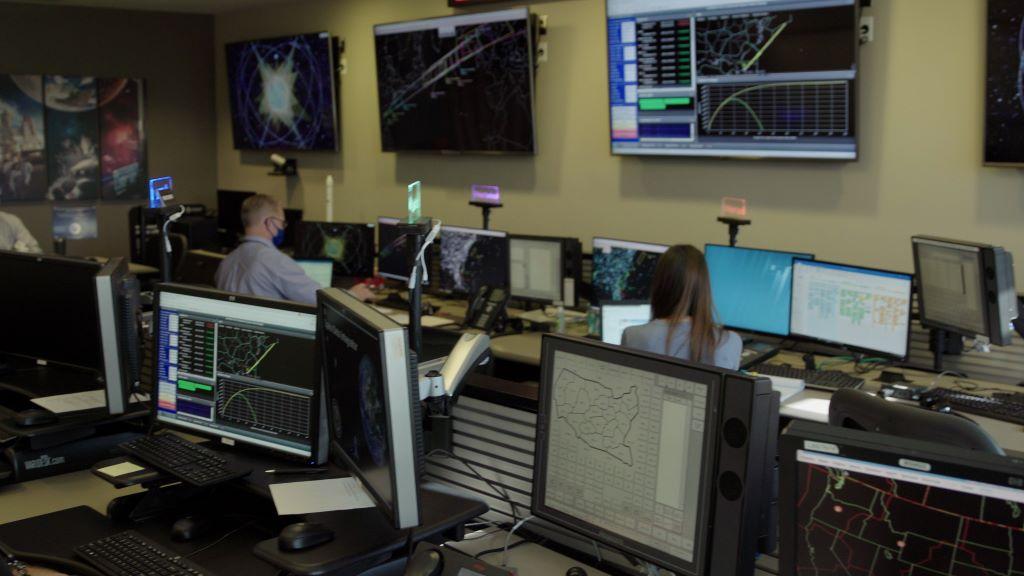An Inside Look At The FAA Command Center

If you think of the National Airspace System (NAS) and its 43,000 daily flights as a symphony, the agency’s Hurley Air Traffic Control Command Center in Warrenton, Virginia just west of Washington, D.C. would be its conductor, according to the FAA.
Those tens of thousands of flights equate to about 70% of the world’s air traffic by the way. However, Command Center personnel do not talk to pilots on the radio, not even one. The 300 personnel at the Command Center adjacent to the Potomac TRACON (Terminal Radar Approach Control Facilities) act as collaborative decision-makers as they attempt to balance the flow of air traffic across the nation.
Each day, information gathering at the Center begins with a call from the Command Center’s National Traffic Management Officer at 0715 Eastern and every other hour after that until 2115 that evening. The call links all the major control towers, TRACONs, en route centers, port authorities, airlines, and affiliated stakeholders, such as the National Business Aviation Association (NBAA), Airlines for America (A4A) and the International Air Transport Association (IATA). Center personnel later create a plan that’s published on the National Airspace System Status website (www.nasstatus.faa.gov). Because the majority of IFR traffic in the skies over the U.S. belong to the airlines, the Command Center tends to be a bit airline-focused. That’s why NBAA assigns one of its own specialists to remind all stakeholders of business aviation’s role in the airspace so the association’s ATC staff can report potential airborne traffic snarls that might affect member flight departments.
Those working at the Command Center also see their mission partly as traffic cops when air traffic metering is needed as when severe weather impacts a hub, such as Chicago, Atlanta, or Miami for example, or when a particular hub is overwhelmed by the sheer number of arrivals. There are times, too, when a shortage of ATC personnel on the ground demands routing around those affected areas or a reduction to the amount of traffic entering that airspace.
The human conductor of the Command Center symphony is known as the National Operations Manager (NOM). It was the NOM who on September 11, 2001, made the decision to ground everything flying in the National Airspace System after watching the events unfold in New York, Pennsylvania, and Washington.
Within the Center sit two National Traffic Management Officers (NTMO), one focused on terminals, the other on severe weather and special traffic events. Within the terminal sector, two different managers also watch traffic at the key hub airports throughout NAS via real-time radar displays. This pair of specialists divide the nation into an east and a west sector normally split around the Mississippi River. Either of these National Traffic Management Specialists are the ones who might judiciously issue ground stops or delay programs to best manage traffic flow through a specific airport.
Depending on how many people are working in the Command Center, the two major geographical areas of responsibility may be split into even smaller sectors when traffic numbers rise, or severe weather begins marching toward a particular terminal. These specialists break down arrival rates into 60-min. and sometimes as little as 15-min. buckets and can even drill down to see what arrival fixes aircraft are planning to head for coming to a major hub. This heads-up helps Center specialists, working in collaboration with the TRACONS, to set the rate of aircraft hub controllers can safely and efficiently deliver traffic to a particular airport. If they see an hour where air traffic will exceed a set rate, they’ll first try metering to slow inbound traffic down and perhaps push a little bit of that extra volume into the next hour. If there is still too much traffic, they may switch to a dreaded ground stop as the last resort.
The Severe Traffic Management Specialist who watches the nation’s weather with help from the Aviation Weather Center personnel also based at Hurley, can call for reroutes or metering to avoid air traffic congestion around areas of thunderstorms or hubs experiencing strong winds. Another issue that pops up more regularly is space launch activity. Now online to aid Center personnel in the launch strategy creation is a system known as the Space Data Integrator (SDI) capable of receiving telemetry directly from the launch operator. For example, the Command Center understood the launch of Artemis from Cape Canaveral would have a significant impact on the north-south traffic through Jacksonville and Miami centers descending on Florida from the New York area in November. That translated into planning how to reroute air traffic overland since flight plans over the Atlantic would be blocked. The Command Center coordinates ahead of time with centers further west – like Washington and Cleveland – to keep things moving.
One specialist said business aviation crews should understand that a ground stop at Denver International, Chicago O’Hare or Atlanta Hartsfield doesn’t necessarily translate into a stop for traffic headed to Rocky Mountain or Chicago Executive or Falcon Field in those cities. A flight plan to an airport at the edge of a major hub’s airspace might offer a quick reroute to the original destination once that aircraft contacts the hub’s TRACON controllers near their destination because that kind of specialization is simply too much to expect from the folks working the national strategy desk at Hurley.
A visit to www.nasstatus.faa.gov offers anyone a quick look at the NAS status where they can view traffic or weather advisories, arrival rates and caps at major hubs, expect departure clearance times (EDCT), pertinent NOTAMs, reroutes, and a look at the national weather feed from the Aviation Weather Center.





Comments